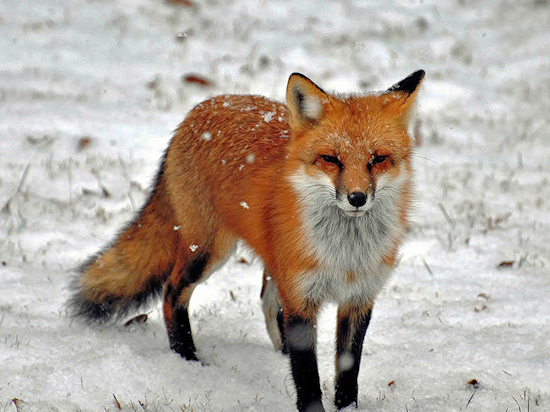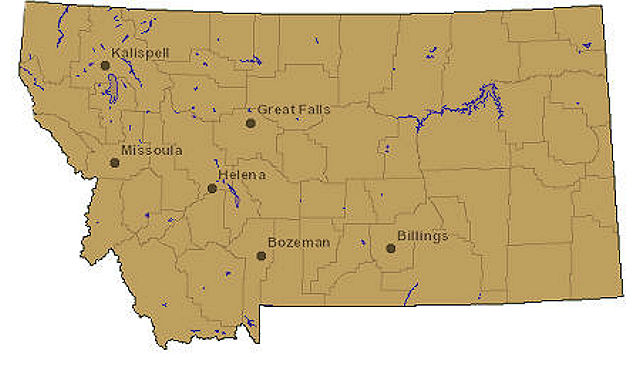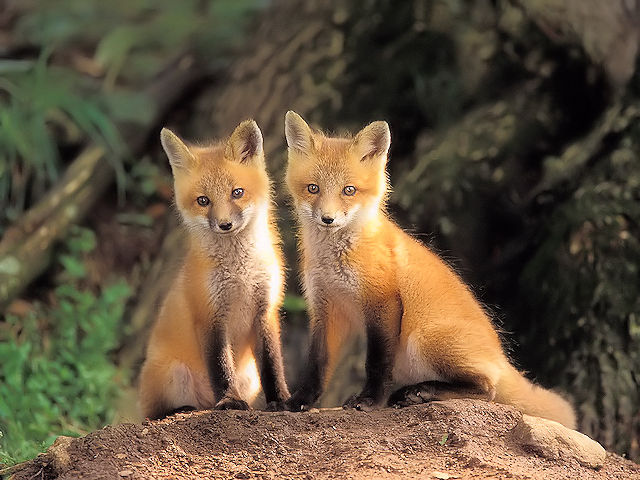Red Fox

Vulpes vulpes
Order:
Carnivora
Family:
Canidae
Status: Valuable fur animal, abundant, unprotected predator.
Identifying Characteristics: Appearance of small dog. Long, bushy tail, pointed ears, slender muzzle, slanted eyes. White tip in the tail. Rufous coloration, various coat colorations or color phases.
Total length: 39 to 43 inches. Weight: 10 to 15 pounds.
Habitat: Can survive in a wide range of habitats. Often associated with agricultural areas. Prefers mixture of forest and open country near water.
Food Habits: Opportunistic predator that sometimes eats carrion. Preys on small mammals, birds, eggs, game birds, ranch animals.
Life History: Mostly nocturnal. Hunts by smell. Uses dens for shelter during severe weather and when pups are being reared. Usually uses dens made by other animals. Mates during winter; 51 to 53 day gestation; litter size averages 4 to 8.
Similar Species: There is no white tip on the tail of the coyote, swift fix, marten, or fisher.
The red fox is easily recognized by it's color. This species is native to North America, and red foxes are widely distributed in the United States and Canada. Red fox are suspicious by nature. Many fox have earned reputations as being clever. This species can adapt to many climates, habitat types, and human population densities. An important farmland predator, red fox are considered by many trappers as being one of the more difficult to trap species.
 Description
Description
The long fur of red fox
gives them an appearance of being larger than
they really are. Red fox commonly weigh 10 to 12
pounds in many areas with occasional large
specimens weighing up to 14 pounds. Red fox are
slightly heavier in the northern parts of their
ranges, and slightly lighter in far southern
locations.
Distinctive marks of red fox include feet that are usually black, with black fur also on the backs of the ears. A white tipped tail is common, and the red colors of the fur mute with grayish or whitish fur on the throat, bottom of the neck and belly areas. Colors vary in sections and with individuals. Many southern red fox are blondish, and darker reddish colors are usually found in northern farmlands and forests. Red fox on the western high plains are somewhat pale in color.
Color phases do occur with red fox, even in the same litters. Color phases are much more apt to occur in northern or colder regions and almost never occur in southern regions. Other than the most common color of red, red fox can be black, silver or a cross between red and silver, known as "cross fox". Black fox have black tipped guard hairs, and silver fox are black with white tipped guard hairs. Cross fox often have reddish sides and dark along the middle of the back area, with a cross of dark colored fur running from one front leg over the back to the other front leg. Relatively uncommon are red fox known as "bastard" fox and "Sampson" fox. Bastard fox lack color and are brownish or grayish in color. Sampson fox have few or no guard hairs in their fur.
The eyes of the red fox are yellow or amber in color, with elliptical pupils. Red fox also have 42 teeth, including 4 canine teeth to help them catch and kill prey species.
 Reproduction
Reproduction
Male and female red fox begin to pair up in
December or January, and mating is usually
accomplished in January. Evidence suggests that
red fox do pair up with the same mates of the
past year, if both are still alive. The litter
is born 52 or 53 days later, usually about
mid-March, in an underground den. These dens are
often located on slopes with good visibility in
all directions, and several entrances and
connecting tunnels are typical. Oftentimes,
these dens are abandoned woodchuck or badger
diggings, which were renovated by the fox. The
average litter size for red fox is 6 to 8 pups.
During the first week after birthing, the female stays in the den with the newborn pups, and the male brings food to the female at the den opening. Later on, both mates hunt to provide food for the litter.
Fox usually have an alternative den selection. The female will not hesitate to move the litter if she feels that the den is threatened. Red fox have one litter a year.
Habits
Red fox have keen senses of sight, hearing and
smell which they use to advantage in avoiding
enemies, and hunting prey species. They are
normally shy, nervous, flighty and they startle
easily. Enemies are escaped by running, and red
fox have been clocked at 45 miles per hour. They
have good endurance and can run for miles when
they are pursued.
Red fox prefer open areas where visibility is good, and often seek out open places in the forests when hunting or resting for the day. Daytime resting areas are usually on elevated spots, such as knolls or haystacks and usually in sunny places during the winter. Underground dens are used mostly during the rearing of the litters and occasionally during windy or stormy weather conditions.
Red fox are curious animals, indicating intelligence. However, their suspicious and shy nature compels them to avoid obvious dangers. They are playful, another indication of intelligence in animals. Some seem to enjoy being chased by dogs, and some red fox will make a game out of uncovering traps. Many times a dropping will be left on the uncovered trap, or nearby, as a communication either to the trapper or to other fox who might happen by.
Fox are well equipped to hunt, and they commonly pounce in a stiff legged fashion upon unsuspecting voles, mice, and rabbits. Other important foods include fruits and berries, grasshoppers, snakes, ground nesting birds, and muskrats . Red fox can and do take domestic fowl when the opportunity presents itself, particularly during the spring when there is a need to provide food for growing litters. White footed mice are an important food source during snow conditions, as these mice travel on top of the snow while most other mice and voles tunnel under the snow.
Red fox do not chew their food, but tend to swallow whole. This accounts for the abundance of fur and crushed food bones found in fox droppings. They commonly kill more food that they eat at one time, and bury the extra food in caches. These caches are made by the fox digging shallow depressions with its front feet. The excess food is then placed in the depression and dirt is pushed over the food with the fox's nose.
The red fox is territorial throughout most of the year, and the choice territories are usually occupied by the more dominant fox. They are thought to mark territorial boundaries by urinating on objects at regular places. These objects are known as "scent stations" and the scent stations seem to be visited by every fox in the area. Territory sizes vary according to fox population densities and the abundance of food. Where red fox are abundant, it appears that territories overlap and in some areas seem to be shared by two or even three different family units. In rare instances, communal denning does occur, with more than one female with her litter sharing the same den. Under good habitat conditions most fox territories will be about 2 or 3 square miles, although, if hunting conditions are good, most fox will stay within a square mile daily, especially in mild weather. Coyotes persecute red fox. Coyotes dominate the better territories where the two species are both found. Red fox move when coyotes are present.
Juvenile red fox begin to wander from family units during August and September. Significant dispersals occur during the months of November , December and January as young fox seek their own territories and mates. Many older red fox who have lost mates also seek new mates. Males seem to travel further than females. Many females prefer to stay in the same territory, even if they have lost their mates. Dispersal distances vary a great deal and are unpredictable. Two Wisconsin red fox were tagged in August of 1962. One of the juvenile male fox was killed the following March 245 miles away in Indiana and the litter mate was killed in June, just 300 yards away from the original den site.
Red fox like to climb up on things in order to get a better view, but they are poor tree climbers. Fox usually avoid getting wet, but they can and do swim when they are forced to.
General
Red fox contribute to the overall health of prey
species by keeping the prey species controlled.
They can and do take domestic fowl when the
opportunity presents itself, particularly during
the spring when there is a need to provide foods
for growing litters. Due to modern farming
practices in many areas, this problem is lesser
than it has been in the past.
Red fox are vulnerable to rabies, and rabid animals can infect pets or even man. They are also vulnerable to several diseases and severe devastation can and does occur when populations are high enough for easy transmission.
Mange and parvo enteritis are two of the most serious fox diseases. Mange is caused by mites which tunnel into the fox's skin, causing irritation and loss of fur. Infections occur as a result of the growing eggs and excrement in the skin, and caking or crusting occurs particularly around the eyes and nose of the infected fox. Nearly naked tails are observed in mange infested fox, and it appears that nearly all foxes infected with mange die slow and painful deaths.
Parvo is a virus that appears to be a mutation of feline distemper. It is probably spread by contact between infected individuals, and symptoms include fever, diarrhea and nervous disorders. Juvenile animals appear to have less resistance to this disease.
12 years of age is considered old for a red fox.